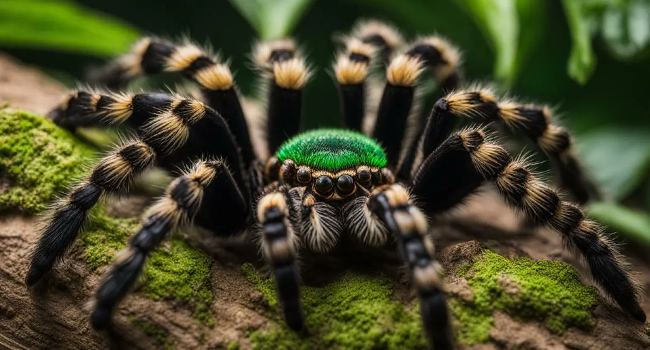Tarantulas, those giant, hairy arachnids that can strike fear into the hearts of many, are fascinating creatures when observed in their natural habitats. This article delves into the world of tarantulas in the wild, shedding light on their behaviors, habitats, and the vital role they play in various ecosystems.
Introduction to Tarantulas
Tarantulas are a type of spider known for their large size, robust bodies, and, often, intimidating appearance. These arachnids are part of the Theraphosidae family and can be found on nearly every continent. Despite their notoriety, they are essential components of various ecosystems.
The Diversity of Tarantula Species
The world of tarantulas is incredibly diverse. With over 900 recognized species, these arachnids come in various sizes, colors, and behaviors. From the vibrant blue Poecilotheria metallica to the enormous Goliath birdeater, each species has its unique characteristics.
Geographic Distribution of Tarantulas
Tarantulas can be found globally, although they are more concentrated in certain regions. They inhabit parts of North and South America. This diverse geographic distribution allows for different species to thrive in a variety of ecosystems.
Natural Habitats of Tarantulas
- Deserts
Desert-dwelling tarantulas, such as the Arizona blonde tarantula, have adapted to arid landscapes. They dig burrows to escape the scorching heat and emerge at night to hunt for prey.
- Rainforests
In rainforests, species like the Gooty sapphire tarantula are vividly colored to blend in with the lush foliage. They build intricate silk retreats in the trees, capturing insects with precision.
- Grasslands
Grassland tarantulas, like the Oklahoma brown tarantula, construct burrows in the ground and hunt within their territories.
Tarantula Behavior in the Wild
Tarantulas are primarily nocturnal, emerging at night to search for prey. They are solitary creatures, only coming together during the mating season. They use their silk not only for web-building but also to line their burrows, creating a safe space for themselves.
Hunting and Feeding Habits
Tarantulas are opportunistic predators, preying on insects, small mammals, and birds.
Mating and Reproduction
Mating for tarantulas is a delicate dance. The male tarantula must approach the female carelessly, as she might see him as a potential meal. Once the mating is successful, the female may lay eggs, which she guards until they hatch.
Tarantula Adaptations for Survival
Tarantulas have evolved to survive in various environments. Some have developed potent venom to subdue prey, while others have sturdy exoskeletons to protect themselves from predators.
Predators and Threats
While tarantulas are formidable predators themselves, they face threats from a variety of creatures, including birds, reptiles, and other mammals.
Conservation Efforts for Tarantulas
Conservationists and researchers are working to protect tarantula populations. This involves preserving their natural habitats and conducting studies to understand these enigmatic creatures better.
The Fascination with Tarantulas
Despite their fearsome reputation, tarantulas have captivated the imaginations of many. They are popular as pets in the exotic pet trade, with enthusiasts maintaining tarantula collections.
Unique Tarantula Species
Some tarantula species stand out due to their exceptional characteristics, such as the Goliath bird eater, known for its size, or the pink toe tarantula, appreciated for its striking coloration.
Tarantula Venom
Tarantula venom varies from species to species. Some have venom potent enough to incapacitate larger prey, while others rely on different tactics for survival.
The Role of Tarantulas in Ecosystems
Tarantulas play a vital role in maintaining the balance of ecosystems. They help control insect populations, preventing outbreaks that can harm vegetation and other wildlife.
The Fascination with Tarantulas
Despite the initial fear that many people associate with tarantulas, these arachnids have captivated the imaginations of enthusiasts worldwide. The fascination with tarantulas extends beyond their mere existence in the wild. Let’s explore some of the reasons behind this fascination.
Unique Aesthetic Appeal
Tarantulas come in a wide array of striking colors and patterns. Species like the Mexican red knee tarantula boast vibrant red and black coloration, while the Brazilian salmon pink bird eater exhibits a beautiful salmon hue. The visual diversity of tarantulas is a significant draw for enthusiasts who appreciate the aesthetics of nature.
Mysterious Behaviors
Observing tarantulas in captivity reveals their intriguing behaviors. Whether it’s their careful construction of silk retreats or their feeding habits, tarantulas offer a captivating glimpse into the intricacies of nature. Their slow, deliberate movements and enigmatic patterns add to the mystique.
Minimal Space Requirements
As pets, tarantulas are relatively low-maintenance. They don’t require an ample living space, making them suitable for individuals with limited room. Their low space requirements and self-contained environments appeal to those interested in keeping exotic pets.
Silent Companions
Tarantulas are silent creatures. Unlike noisy or high-maintenance pets, they make excellent companions for those who prefer a quieter, more tranquil living environment. Their presence can be soothing and meditative.
Educational Value
For educators and researchers, tarantulas serve as an educational tool. Studying these creatures offers insights into arachnid biology, behavior, and ecology. They provide opportunities for learning about adaptation, survival, and the delicate balance of ecosystems.
Conservation Awareness
Tarantula enthusiasts often become advocates for the conservation of these species in the wild. Their passion for these arachnids can contribute to efforts aimed at preserving natural habitats and protecting tarantula populations.
Therapeutic Benefits
Some individuals find solace in caring for tarantulas. Observing and tending to these creatures can have therapeutic effects, reducing stress and promoting mindfulness.
Citizen Science
Enthusiasts and pet keepers can contribute to citizen science projects that collect data and promote understanding of tarantula behavior and biology. Their observations can aid in furthering scientific knowledge.
In summary, tarantulas offer a unique blend of aesthetic appeal, captivating behaviors, and a low-maintenance lifestyle that attracts both novices and experienced enthusiasts alike. They can be intriguing pets and educational subjects, fostering a deeper connection with the natural world.
The Superstitious Tarantula Venom
One of the most intriguing aspects of tarantulas is their venom. While it’s essential for capturing and immobilizing prey, it varies widely between species. Some tarantulas possess venom potent enough to incapacitate larger prey, while others use different tactics to ensure survival.
The composition of tarantula venom can be quite complex, containing a mixture of proteins, peptides, and enzymes. These components work together to paralyze the tarantula’s prey, allowing the arachnid to feed on its catch. The venom also contains enzymes that help break down the prey’s tissues, making them easier to digest. In the wild, tarantulas have adapted their venom to suit their particular hunting needs. Some species rely on quick-acting venom to subdue agile insects, while others have developed malignancy with a broader range of effects, suitable for more significant or more challenging prey.
Conclusion
In conclusion, tarantulas in the wild are extraordinary creatures that have adapted to diverse habitats worldwide. Their behaviors, hunting strategies, and unique characteristics make them a subject of fascination for researchers and enthusiasts alike. While they may evoke fear in some, these arachnids play a crucial role in the ecosystems they inhabit.
FAQs
-
Are all tarantulas venomous?
No, not all tarantulas are venomous. While most have venom to subdue their prey, the potency varies between species.
-
Can tarantulas be kept as pets?
Yes, many tarantula species are kept as pets by enthusiasts. However, it’s essential to research the specific care requirements for the species you’re interested in.
-
Are tarantulas endangered?
Some tarantula species are threatened due to habitat loss, but not all are endangered. Conservation efforts are in place to protect vulnerable populations.
-
How long do tarantulas live in the wild?
The lifespan of a wild tarantula can vary depending on the species. Some live for several years, while others may have shorter lifespans.
-
Do tarantulas have any ecological significance?
Yes, tarantulas play a vital role in ecosystems by helping control insect populations, which, in turn, maintains the balance of these environments.







